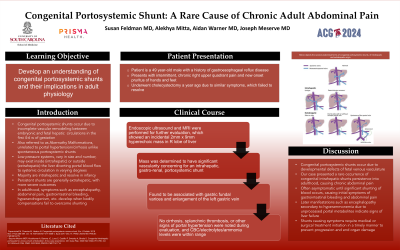Sunday Poster Session
Category: Biliary/Pancreas
P0125 - Congenital Portosystemic Shunt: A Rare Cause of Chronic Adult Abdominal Pain
Sunday, October 27, 2024
3:30 PM - 7:00 PM ET
Location: Exhibit Hall E

Has Audio

Susan Feldman, MD
Prisma Health, University of South Carolina School of Medicine
Columbia, SC
Presenting Author(s)
Susan Feldman, MD, Alekhya Mitta, , Joseph Meserve, MD, Aidan Warner, MD
Prisma Health, University of South Carolina School of Medicine, Columbia, SC
Introduction: Portosystemic shunts frequently arise as secondary malformations in the setting of portal hypertension and cirrhosis. Rarely, these vascular connections arise as primary malformations in patients with an otherwise healthy liver. Known as congenital portosystemic shunts (CPSS), or an Abernathy malformation, these occur due to developmental defects of fetal venous vasculature. CPSS manifest as intra or extrahepatic, with the majority being intrahepatic with spontaneous resolution in infancy. Persistent shunts are largely extrahepatic, with worse outcomes. Although patients can be asymptomatic into adulthood, they are eventually unable to overcome systemic shunting causing encephalopathy, abdominal pain, gastrointestinal bleeding, hyperandrogenism, pancreatitis to develop.
Case Description/Methods: We present a 49- year-old male with a history of gastric reflux who presented with intermittent, chronic right upper quadrant discomfort and new onset pruritus of the hands and feet. A cholecystectomy was done one year prior due to similar symptoms, which failed to resolve. An endoscopic ultrasound and MRI showed an incidental 2 mm x 9 mm hyperechoic mass in the right lobe of the liver with significant vascularity, concerning for an intrahepatic, gastrorenal portosystemic shunt. Gastric fundal varices and enlargement of the left gastric vein were noted in EUS with no signs of portal hypertension. Blood counts, electrolytes, and ammonia levels were normal. A referral was placed to interventional radiology for balloon-occluded retrograde transvenous obliteration.
Discussion: Congenital portosystemic shunts are rare anomalous vascular connections, occurring secondary to an abnormal involution of fetal vasculogenesis. Although congenital intrahepatic shunts commonly resolve in childhood, we presented a persistent intrahepatic shunt with developments of chronic abdominal pain. Initial signs of a congenital portosystemic shunt are often nonspecific, such as gastrointestinal bleeds or abdominal pain caused by significant shunting of blood. Manifestations, such as encephalopathy secondary to hyperammonemia due to unprocessed portal metabolites, indicate signs of liver failure, requiring medical or surgical intervention to prevent progression. Proper diagnosis and treatment of these shunts can prevent non-reversible end organ damage.
Disclosures:
Susan Feldman, MD, Alekhya Mitta, , Joseph Meserve, MD, Aidan Warner, MD. P0125 - Congenital Portosystemic Shunt: A Rare Cause of Chronic Adult Abdominal Pain, ACG 2024 Annual Scientific Meeting Abstracts. Philadelphia, PA: American College of Gastroenterology.
Prisma Health, University of South Carolina School of Medicine, Columbia, SC
Introduction: Portosystemic shunts frequently arise as secondary malformations in the setting of portal hypertension and cirrhosis. Rarely, these vascular connections arise as primary malformations in patients with an otherwise healthy liver. Known as congenital portosystemic shunts (CPSS), or an Abernathy malformation, these occur due to developmental defects of fetal venous vasculature. CPSS manifest as intra or extrahepatic, with the majority being intrahepatic with spontaneous resolution in infancy. Persistent shunts are largely extrahepatic, with worse outcomes. Although patients can be asymptomatic into adulthood, they are eventually unable to overcome systemic shunting causing encephalopathy, abdominal pain, gastrointestinal bleeding, hyperandrogenism, pancreatitis to develop.
Case Description/Methods: We present a 49- year-old male with a history of gastric reflux who presented with intermittent, chronic right upper quadrant discomfort and new onset pruritus of the hands and feet. A cholecystectomy was done one year prior due to similar symptoms, which failed to resolve. An endoscopic ultrasound and MRI showed an incidental 2 mm x 9 mm hyperechoic mass in the right lobe of the liver with significant vascularity, concerning for an intrahepatic, gastrorenal portosystemic shunt. Gastric fundal varices and enlargement of the left gastric vein were noted in EUS with no signs of portal hypertension. Blood counts, electrolytes, and ammonia levels were normal. A referral was placed to interventional radiology for balloon-occluded retrograde transvenous obliteration.
Discussion: Congenital portosystemic shunts are rare anomalous vascular connections, occurring secondary to an abnormal involution of fetal vasculogenesis. Although congenital intrahepatic shunts commonly resolve in childhood, we presented a persistent intrahepatic shunt with developments of chronic abdominal pain. Initial signs of a congenital portosystemic shunt are often nonspecific, such as gastrointestinal bleeds or abdominal pain caused by significant shunting of blood. Manifestations, such as encephalopathy secondary to hyperammonemia due to unprocessed portal metabolites, indicate signs of liver failure, requiring medical or surgical intervention to prevent progression. Proper diagnosis and treatment of these shunts can prevent non-reversible end organ damage.
Disclosures:
Susan Feldman indicated no relevant financial relationships.
Alekhya Mitta indicated no relevant financial relationships.
Joseph Meserve: Pfizer – Advisor or Review Panel Member.
Aidan Warner indicated no relevant financial relationships.
Susan Feldman, MD, Alekhya Mitta, , Joseph Meserve, MD, Aidan Warner, MD. P0125 - Congenital Portosystemic Shunt: A Rare Cause of Chronic Adult Abdominal Pain, ACG 2024 Annual Scientific Meeting Abstracts. Philadelphia, PA: American College of Gastroenterology.
